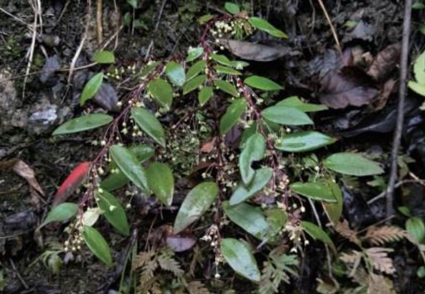Abstract
Nymphanthus calcicola, a new species from Pengshui county of Chongqing, China, is described. The new species is similar to N. bodinieri (Lévl.) R.W. Bouman in morphology, but differs from the latter by its cylindrical and twisting branchlets, elliptic or lanceolate leaves that are acuminate or acute at apex and broadly cuneate to slightly round at base, inconspicuous midrib of leaf blades adaxially, triangular-subulate stipules, larger flowers (female flowers 6.5–8.0 mm in diameter and male flowers 5.5–6.5 mm in diameter), longer pedicels of male flowers (10–20 mm long), depressed globose ovary, deeply bifid stigmas and obscurely grooved fruits.
References
Barrett, R.L. & Telford, I.R.H. (2015) Two new species of Phyllanthus from northern Australia and notes on Phyllanthus, Sauropus and Synostemon (Phyllanthaceae) in Western Australia. Nuytsia 26: 149?166.
Bouman, R.W., Kebler, P.J.A., Telford, I.R.H., Bruhl, J.J. & van Welzen, P.C. (2018) Subgeneric delimitation of the plant genus Phyllanthus (Phyllanthaceae). Blumea 63: 167?198. https://doi.org/10.3767/blumea.2018.63.02.14
Bouman, R.W., Kebler, P.J.A., Telford, I.R.H., Bruhl, J.J., Strijk, J.S., Saunders, R.M.K., Essr, H.J., Falcón-Hidalgo, B. & van Welzen, P.C. (2022) A revised phylogenetic classification of tribe Phyllantheae (Phyllanthaceae). Phytotaxa 540 (1): 1?100. https://doi.org/10.11646/phytotaxa.540.1.1
Chakrabarty, T. & Balakrishnan, N.P. (2018) Glochidion. Indo-Burmese Phyllanthaceae: A taxonomic Revision. Bishen Singh Mahendra Pal Singh, Dehra Dun, pp. 194–255.
Chantaranothai, P. (2007) Phyllanthus. In: Chayamarit, K., van Welzen & P.C. (Eds.) Flora of Thailand 8 (2). Royal Forest Department, Bangkok, pp. 473–507.
Dumortier, B.C.J. (1829) Analyse des Familles des Plantes. Impeimerie de J. Casterman, Tournay, 104 pp.
Hoffmann, P., Kathriarachchi, H. & Wurdack, K.J. (2006) A phylogenetic classification of Phyllanthaceae (Malpighiales; Euphorbiaceae sensu lato). Kew Bulletin 61: 37–53.
IUCN Standards and Petitions Committee. (2019) Guidelines for Using the IUCN Red List Categories and Criteria (Version 14). Prepared by the Standards and Petitions Committee, pp. 9?16. [http://www.iucnredlist.org/documents/RedListGuidelines.pdf]
Kathriarachchi, H., Samuel, R., Hoffmann, P., Mlinarec, J., Wurdack, K.J., Ralimanana, H., Stuessy, T.F. & Chase, M.W. (2006) Phylogenetics of tribe Phyllantheae (Phyllanthaceae; Euphorbiaceae sensu lato) based on nrITS and plastid matK DNA sequence data. American Journal of Botany 93 (4): 637–655. https://doi.org/10.3732/ajb.93.4.637
Kress, J., Robert, A., DeFilippes, E. & Kyi, Y.Y. (2003) A Checklist of the Trees, Shrubs, Herbs, and Climbers of Myanmar. Contributions from the Unites States National Herbarium 45: 1–590.
Léveillé, A.A.H. (1915) Flore du Kouy-Tchéou. Le Mano, Paris, 535 pp.
Li, P.T. & Gilbert, M.G. (2008) Phyllanthus. In: Wu, Z.Y., Raven, P.H. & Hong, D.Y. (Eds.) Flora of China Vol. 11, Science Press, Beijing and Missouri Botanical Garden, St. Louis, 180–190.
Linneaus, C. (1753) Species Plantarum. Laurentius Salvius, Stockholm, 1200 pp.
Martynov, I. (1820) Tekhbo-Botanicheskii Slovar. Imperatorskaja Rossiskaja Akademia, St. Petersburg, 369 pp.
Nguyen, N.T. (2007) Taxonomy of Euphorbiaceae in Vietnam. Vietnam National University Publishers, Hanoi, 179 pp.
Pornpongrungrueng, P., Parnell, J.A., Hodkinson, T.R. & Chantaranothai, P. (2017) Phyllanthus kaweesakii (Phyllanthaceae), a new species from Thailand. Botany 95: 567?577. https://doi.org/10.1139/cjb-2016-0298
Pruesapan, K., Telford, I.R.H., Bruhl, J.J. & van Welzen, P.C. (2012) Phylogeny and proposed circumscription of Breynia, Sauropus and Synostemon (Phyllanthaceae), based on chloroplast and nuclear DNA sequences. Australian Systematic Botany 25 (5): 313–330. https://doi.org/10.1071/SB11005
Ribeiro, R.T.M., Neto, R.L.S. & Loiola, M.I.B. (2017) Phyllanthus carmenluciae, a supreme species of Phyllanthus (Phyllanthaceae) from Brazil. Phytotaxa 305: 35?40. https://doi.org/10.11646/phytotaxa.305.1.5
Sunil, C.N., Prabhukumar, K.M., Kumar, V.V.N., Thomas, V.P., Bhavadas, N. & Balachandran, I. (2016) Phyllanthus balakrishnanii sp. nov. (Phyllanthaceae), an interesting discovery from the southern Western Ghats, India. Phytotaxa 273: 65?71. https://doi.org/10.11646/phytotaxa.273.1.7
Thiers, B. (2022 [continuously updated]) Index Herbariorum: A global directory of public herbaria and associated staff. New York Botanical Garden’s Virtual Herbarium. The New York Botanical Garden, New York. Available from: http://sweetgum.nybg.org/ih/ (accessed 22 May 2022).
van Welzen, P.C., Pruesapan, K., Telford, I.R.H., Esser, H.J. & Bruhl, J.J. (2014) Phylogenetic reconstruction prompts taxonomic changes in Sauropus, Synostemon and Breynia (Phyllanthaceae tribe Phyllantheae). Blumea 59 (2): 77–94. https://doi.org/10.3767/000651914X684484


